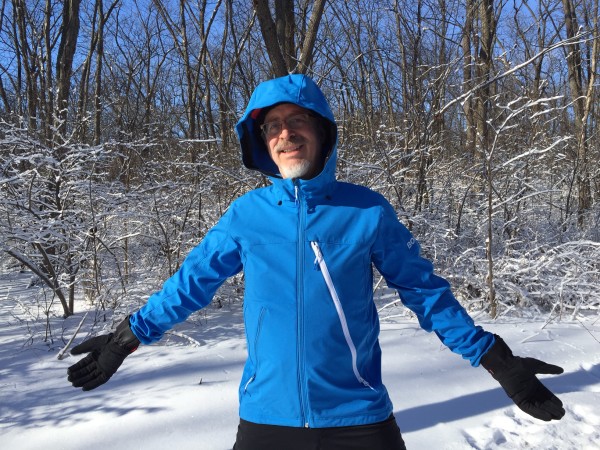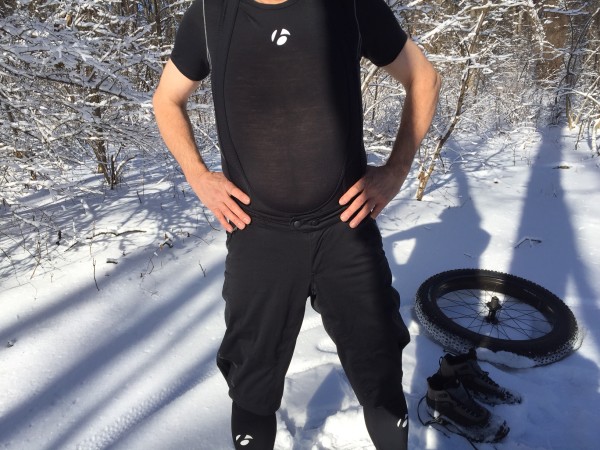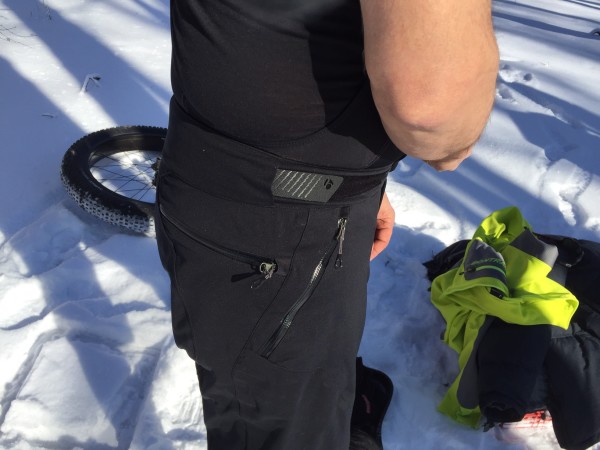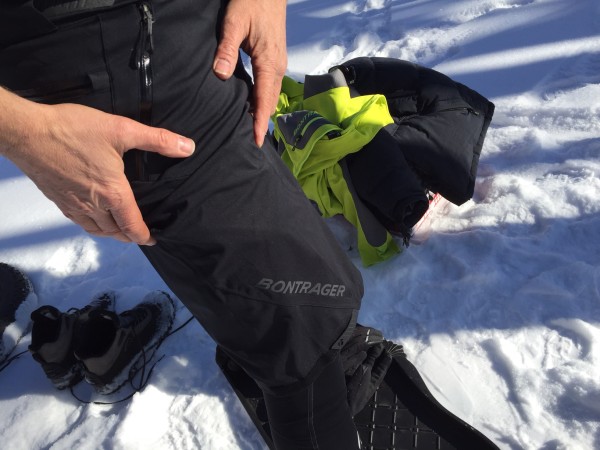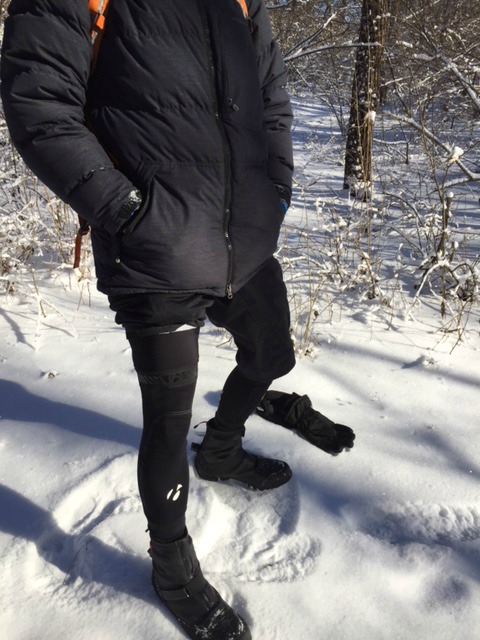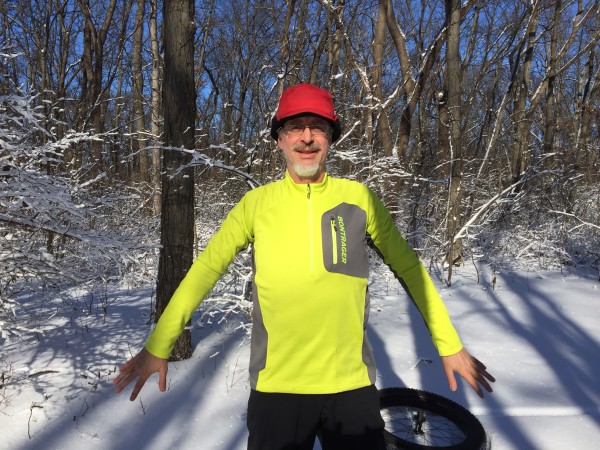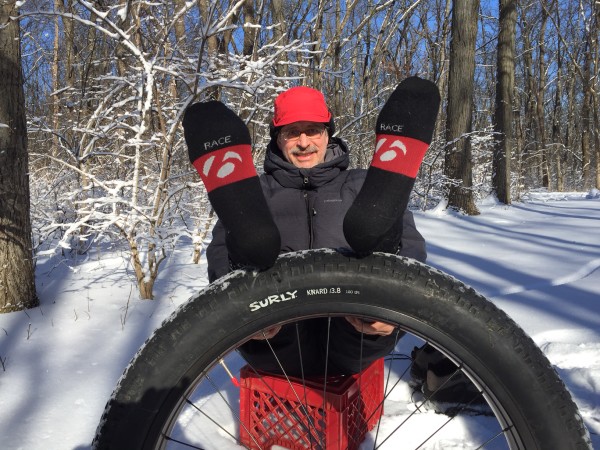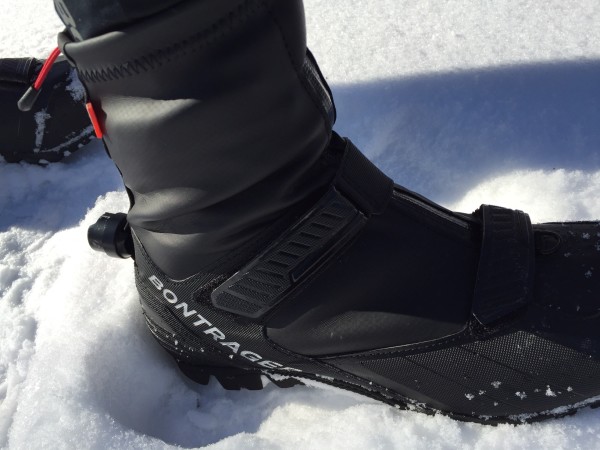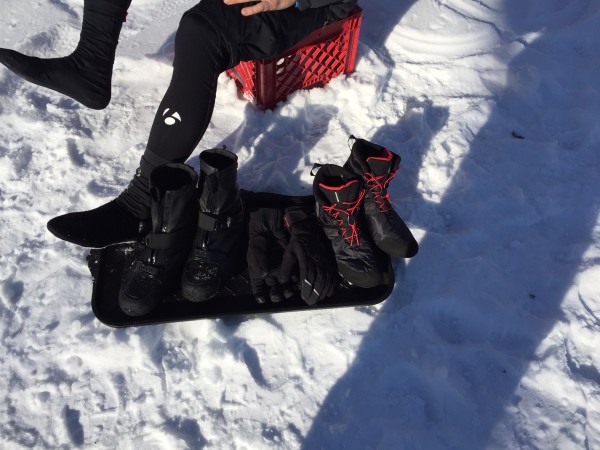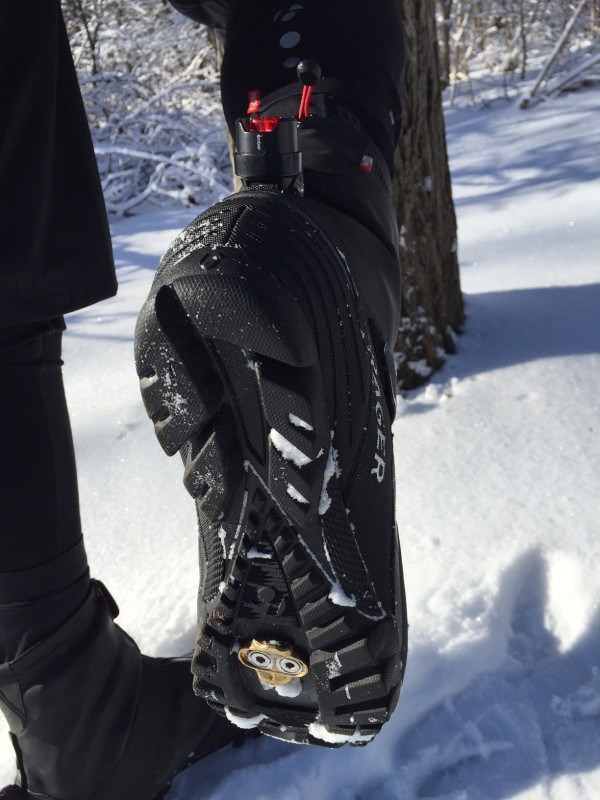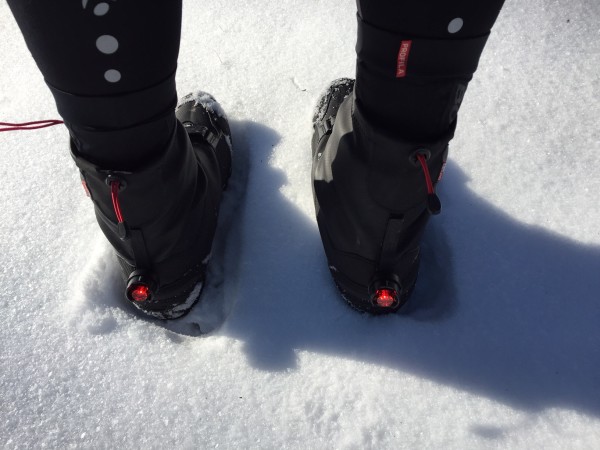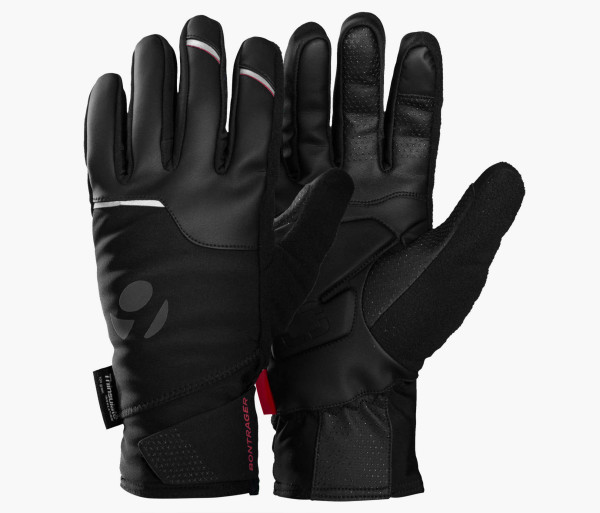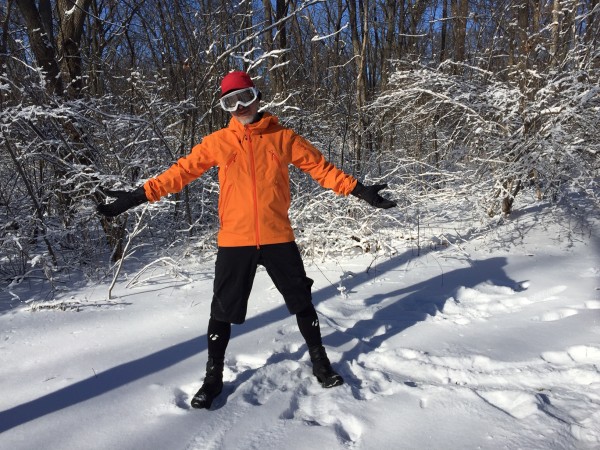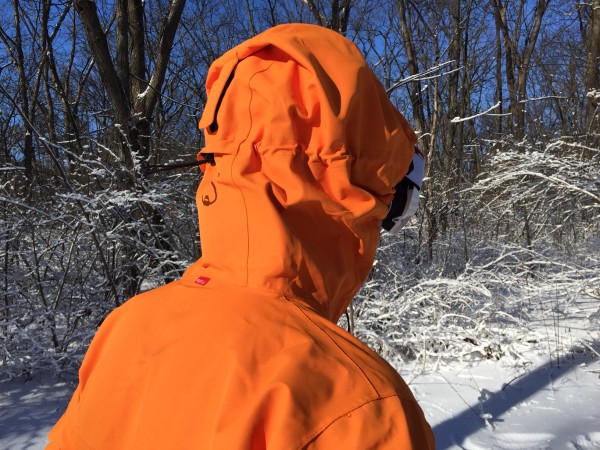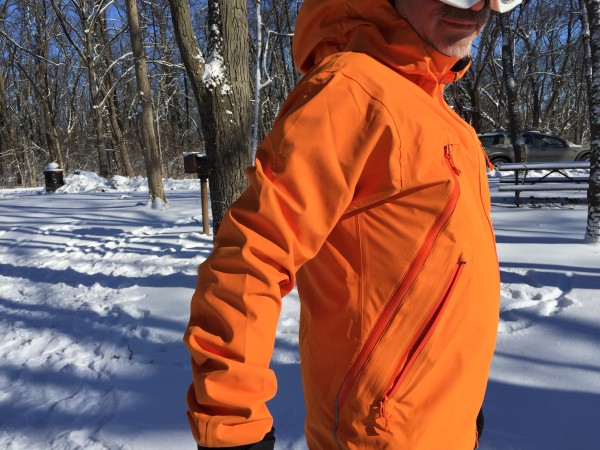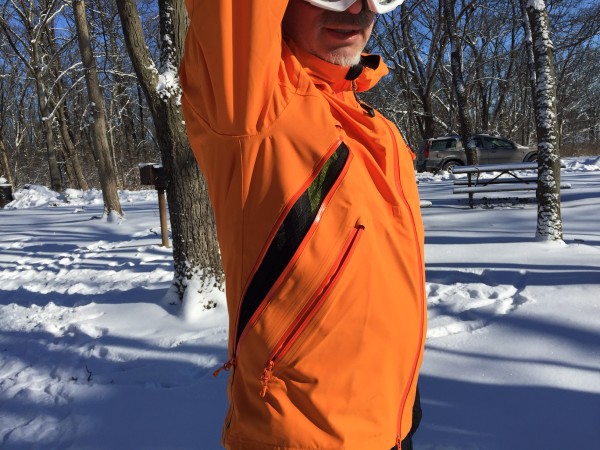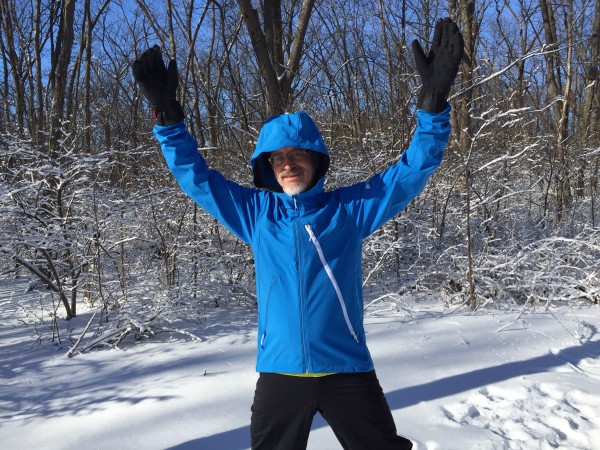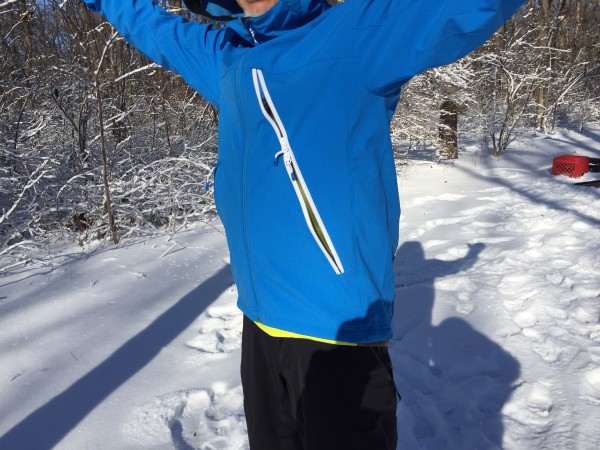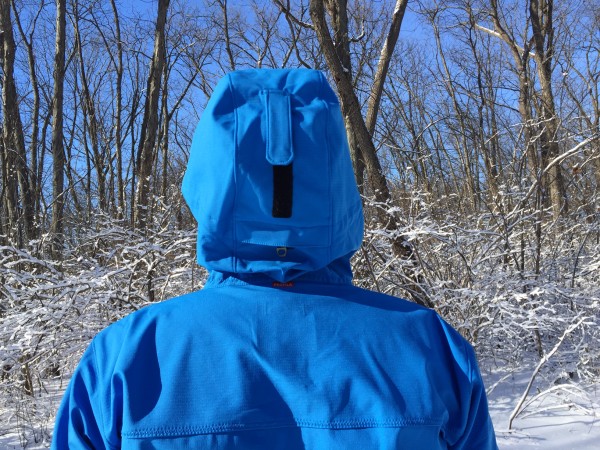Fat-bike.com readers and riders…I’m on a mission from Bontrager this month. Gomez has handed me the motherlode of winter gear for testing, and I have been putting it through the ringer to find the cream of the Fat-bike crop for you.
First up we have the all important base layers. The Bontrager B2 Short Sleeve Baselayer is listed as a lightweight baselayer for mild temperatures. Made of a unique combination of 37.5 active particle technology polyester fibers and Merino wool. While I was unable to count the actual number of active particles myself, it did perform admirably in some tough aerobic fatbiking conditions, between 20 and 50 degrees F. It did wick sweat incredibly well, and was designed to operate best at the human preferred 37.5% humidity. It has a 3″ drop tail in the back, which allowed it to stay tucked in to my Bontrager shorts nicely. It has survived 10 trips through the washing machine and still has perfect shape and fit.
Bontrager Thermal Bib Shorts are covering my lower layer. Made from a thermal Profila fabric, they are designed to trap heat and wick moisture. The inForm Race chamois was just the right density to be comfortable without bunching or feeling too thick. The silicone leg grippers stayed in place no matter how many times I stood on the pedals while climbing, or slid forward or back on the seat in challenging terrain. The shoulder straps are thin and very flexible, which makes them practically disappear under my other layers. Since I usually wear some kind of backpack or hydration pack when riding, it was nice to find these bibs straps played well together. The front of the shorts is cut low enough to allow normal trailside breaks. I found these to be among the most comfortable bike shorts I have ever worn. They have washed up well, and still look new.
At this point we start getting to the meaty parts of the equipment. Baggy shorts have been a mainstay of the off road cycling world since before tires became fat. Bontrager sent me Evoke Stormshell Shorts. Stormshell you say? Why would anyone want water resistant shorts? Well, for at least two reasons: Lycra and winter. First off, summer cycling has dominated the landscape for years. The sad end of summer and the wearing of long pants has been has long been mourned by cyclists. Therefore the first step toward accepting cold weather has been baggies and leg warmers, or baggies and thermal tights.
The Stormshell shorts have the perfect combination of features that make this transition easier. Windproof, breathable fabric, while not insulated, is both windproof enough to keep your naughty bits warm and your heat managed at the same time. Every technical feature you could ask for has been perfectly sewn into place. The construction and materials used are all first rate. All seams are taped as you would expect from a water resistant garment. Plenty rugged for fatbiking adventures while looking good, possibly even understated. Matte black material finish, with only a subtle black Bontrager logo printed on the leg. This was the only item in the test that was not quite shouting its branding. Good pockets are my #1 priority in almost any baggy biking short. There are two slash hand pockets in front, and one pocket in the right rear. All these pockets have serious waterproof silicone zippers, so your bar money and the pictures of your honey stay dry. There is a zippered fly, and a substantial combination velcro/2 snap waist closure. The waist also has a pair of velcro side adjusters to tailor the waist size without wearing a belt. Even the leg openings have velcro closures that would allow you to customize fit, style, and ventilation. The Stormshell shorts do not have a built in padding, because typically the bib shorts or long tights you wear underneath would cover that nut. You could wear padded liner shorts or regular lycra cycling shorts underneath, or any different thickness of thermal tights or leg warmers. Since so much of winter fatbiking comfort is the effective use of layering, these shorts have a very nice niche in the whole system.
As far as fit goes, the length hit me right about the middle of the knee when standing. My waist is a fairly consistent 34″, and the size medium was slightly snug. Enough to fit my windfront tights, but not enough to tuck in my thermal jersey. The fit guide shows waist size 81-84 cm, which maxes out at 33”. Order sizes accordingly.
Working downward, Bontrager Thermal Leg Warmers are next. Their thermal leg warmers have a fleece lining and zippered ankles to ease their installation. Zippers definitely made it easier to slide them over my size 11 feet, and the warmers are definitely full length at 24″ long. They are clearly marked Left and Right , and carefully sculpted to fit the appropriate appendages. I wore these on a sunny 30 degree day with the Stormshell shorts and was quite comfortable.On the day these photos were taken it was only 9 degrees, a little too cold for these. I enjoyed having the ankle zippers, when I found it was possible to unzip and pull them up to get some ventilation while riding.The silicone grippers kept them from sliding down until I was ready to remove them. The warmers were plenty long enough to be covered at the top by the Stormshell Shorts. Simple product, well executed.
My next layer is the Bontrager Evoke Thermal Jersey. This arrived in a vibrant green color, which is attention getting without being too neon bright. There are gray accent panels along the sides and under the arms. This gray material seems to be slightly more breathable than the green colored front and back panels. The whole garment has a very soft feel, with a lightly quilted texture that strikes a good balance between warmth and breathability. There is a 3.75″ drop hem in the rear, which prevented plumbers crack at all times. It was very warm when layered under a jacket in snow conditions but breathable enough to wear with just a baselayer (see above) in 45 degree weather during high output activity. There is an 11.5″ neck zipper, and one zippered chest pocket. I am particularly fond of this chest pocket because it easily accepted my iPhone 6 and kept it functioning in very cold weather. The built-in eyeglass wipe on the interior hem was handy during breaks in the action. Everything is double stitched, and all seams were smooth and comfortable. This garment is semi-fitted, which means the size medium fit well both in arm and torso length, including my slightly beer enhanced waist. I actually received quite a few compliments on this jersey, which does not always occur with cycling specific garments. My only complaint is that the front of the shoulders feels slightly odd when you first put it on. This disappears the moment you reach your arms forward, as if reaching for the handlebars. Truly designed for riding comfort.
In order to keep feet happy, Bontrager has provided both the Race 5″ and Race 7″ Wool Socks. These are 60% nylon, 38% Merino wool, and 2% miracle stretch Spandex. These are performance training and racing socks, and fit into the medium to thin range of sock thickness. I can easily wear these with a thin liner sock in my normal cycling shoes when the weather starts to cool down. I paired them with a slightly thicker sock for use with the Old Man Winter cycling boots, reviewed here later. The 60% nylon made it easier to slip on or over other socks, and the 38% Merino wool provides warmth, wicked moisture, and prevented funky foot odors. The size large fit my size 11 feet, and were a good match for my cycling specific calves.
The final layer to seal in the warmth is the Stormshell Over Sock.The size L rated to fit US 10-11 fit very well and was easy to put on. It is a very thin membrane, and barely takes up any space inside the boots. I wore them directly in the snow at 9 degrees for these pictures, and while the snow melted my feet did not get wet.Unfortunately they did not seem to make my boots much warmer, so more test sessions would be needed to confirm their usefulness. I do own two pairs of competing brand barrier socks, and both are thicker but more effective.
This month I have also been testing the newest winter cycling boot offering, the Old Man Winter. Bontrager has entered the winter cycling shoe market with a boot that has every design detail you could ask for, plus a few you never even dreamed of. While unboxing these beauties, I was immediately impressed by their light weight and slim profile. I am used to riding in some normal winter hiking boots, which are pretty large and heavy, while the Bontragers are just slightly larger than normal cycling shoes. The outside material which is aptly named GnarGuard, is fairly smooth and seems pretty rugged. They easily shrugged off briars and thorny vines that are common in my riding area. Burrs that seem magnetically attracted to my winter cycling pants did not stick to these shoes at all.
There is a waterproof zipper on the front in the center, and two Velcro straps to help adjust the fit. Opening the Velcro and zipper reveals an inner bootie filled with 200 grams of 3M Thinsulate insulation. Surprisingly there is a Boa style Kevlar lacing system that helps adjust the inner bootie the fit more precisely. It has a quick release lock that allows the laces to be snugged up to your preference, no tieing required. This lacing system keeps the liners much more compact and prevents them from being too bulky. The booties are easily removed from the boots, and I found that was the easiest way to put them on my feet. The booties have removable insoles made of quality closed cell elastomer, with a layer of heat reflecting Mylar foil on the bottom. I like the fact that these are easy to take out, since it makes it easier to clean and dry them after use.
After I started using the boots regularly I noticed that the fleece lining of the booties, which is very soft and comfortable, was also somewhat resistant to sliding my normal wool socks inside. I have been graced with some Bontrager winter cycling socks, which somehow are more compatible with the liners. Don’t ask me how this works, but it does. The Stormshell Oversocks have a very smooth finish, and the inner booties went on and off easily with them in place. Anyway, the resulting fit is very comfortable and will be very adjustable to accommodate your choice of socks. I normally wear size 11, and I obtained a size 11.5 to allow for some flexibility. So far this sizing scheme is working well for me. I have logged 20 rides, both off and on road. Temperatures have ranged from about 40 degrees down to about 8 F, and I must say these boots are super warm. I was actually able to shed a layer I would normally be riding in due to the extra warmth provided by the OMW’s.
These boots are about 9” tall, which keeps in heat and keeps out some snow. The openings at the top do have a drawstring that could snug up the fit if needed. In my testing there was not quite enough room at the ankle, even when opened all the way. There can be some interference between thick tall socks and the the ankles of thermal tights, so I ended up going with slightly shorter socks. If your winter gear fits over the top of the boots this is less of an issue. I would recommend trying them with the gear you intend to use for the coldest weather you are facing.
The soles have the regular nut plates for mounting normal SPD cleats ( I am using Crank Bros brass cleats). The bottoms of the soles have a grippy mountain bike tread, comparable to other Bontrager MTB shoes. They were fine for some uphill trudging and hike-a-bike sections. Interesting to note that Bontrager rates the stiffness of the soles at a 6, which means they are not ultra stiff race shoes. This was perfect for me, as I feel that flexible shoes help keep feet warmer by allowing more natural movement.
I wore them with some Crank Bros Mallet clipless pedals, which worked great and did not require spacers or trimming.
I also tried them with three types of flat pedals: Generic, Crank Bros 50/50, and Wellgo MG-1. This was not successful, as the pins of my pedals did not coincide with the lugs on their tread. That is not their intended use, but I am just confirming for those who might try.
One of the best features incorporated is the rear blinkie light mount built into the back of the ankle area of the boots. There are small straps designed for attaching the Bontrager Ember tail lights on both boots. The Ember lights are small, about 1″ in diameter, and only weigh 18 grams each. Ember lights have 2 modes, steady on and flashing, and are rated at 3 lumens. Powered by two CR2032 batteries, which are rated for 100 hours of use. I am completely cranked about this light feature, since the majority of my winter riding is done at or near dusk , or at night. Often I take the road to get to my local riding spot, and this light mount position really provides a bright, moving signal to traffic approaching from behind. Easily installed or removed, the Ember can also be used year round for mounting to your seatpost or the back of your helmet.

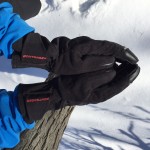

For the hands I have the two pairs of gloves.First, the Stormshell Gloves. These are made from a similar Stormshell material as the other items tested, and have padded palms and a fleece lining. There are fleece wipers on the forefinger and thumb, which are very soft and function perfectly. There are E-Swipe fingertips so you can answer your phone or razz your biking buddies by text when they are late or lost.The velcro wrist is long, and easy to open and adjust. The fingers and palms have a grippy surface texture that worked well with my handlebar grips and the slippery finish of my carbon framed bike. They fit my size XL hands well, but did not have much extra space inside. No room for hand warmers in extreme low temperatures. I wore these all through December, when it rained and temps were moderate. While they did keep my hands dry in the rain, anything above 45 degrees was too warm. Unfortunately, anything below 35 degrees was not warm enough, and after one hour or so my hands got cold. I think these gloves did not breathe well enough, and that some insulation not only would keep hands warmer, but would absorb perspiration longer. I would prefer some gloves with a wider range of useful temperature, and a looser fit in the palm or back to allow hand warmers.
Next there is the Velocis Softshell glove. Warm hands keep me happy and gripping and shifting as I ride, and these have been great. 70g of Thinsulate insulation has kept my hands toasty into the low twenties. The palms have inForm gel pads which are just the right size and density for me. They have a long, velcro closure cuff that is easily 3″ longer than a regular cycling glove to avoid the dreaded wrist gap that wastes precious body heat. The most obvious cycling specific feature is the generous exterior fleece on the forefinger and on the thumb, for wiping foggy goggles and drippy noses. There are some reflective accents on the back, and silicone gripper dots on the thumb and first two fingers to insure good shifter and brake lever traction. The forefingers also have a phone friendly E-Swipe surface so you can answer the important calls that always seem to come when you are riding.
These gloves were good to my hands on 20 degree night rides up to 2 hours long. They are a very good compromise between warmth and dexterity. I used them for both commuting and snow riding. While I prefer five finger gloves for most riding, I think I would switch to some lobster style or mitten style gloves if it were closer to 15 degrees or lower. I usually wear a size XL, and these fit great in the fingers, but would not have room to slip a chemical handwarmer inside. For true fatbiking gloves I would like to see a more roomy fit, or even a zippered pocket on the back of the glove for a handwarmer packet. Please accept my apologies for the use of a stock photo here, but on photo day someone nicked them off the hood of my car while I was shuttling equipment.
Two jackets arrived for testing. First up is the Bontrager Lithos Stormshell Jacket. Advertised as waterproof, windproof, and breathable, it pulled off most of those duties well. The color is bright enough for visibility but soft enough to look good. It also matches some Trek Bicycle frame graphics if you are interested in style.The fit is roomy, and allows for some layering. The hood is generously cut and can easily fit over a helmet, or by pulling a drawstring, fits much closer to a regular hat size. The hood has a rear drawstring, a front drawstring, and a top velcro tab for making the fit just right.
It has the same waterproof zippers that I loved on the Stormshell Shorts. These front venting zippers deserve special mention due to both their length and placement. At 18” long, they run nearly the full length of the jacket. They are backed by an open mesh material. There are two zippered slash pockets which also act as vents. With up to four vents in the front, the temperature range of this jacket is much wider than a normal rain coat. There is an interior chest pocket with room for your phone. The cuffs on the sleeves have a velcro closure to keep out rain or keep in warmth. The main front opening zipper is also a two way zip that can open from the bottom as well as the top. This helps adjust your venting and comfort. I wore this jacket through most of December, when it rained almost every day and the temperatures were pretty mild. I went on some rides at 45 degrees and rain, and one ride at 35 degrees, 15 mph wind, and light rain. When riding in the rain it was possible to close the zipper on the windy side, and open the zipper on the dry side. This helped manage my temperature and kept me warm and dry.
That said, there is still much to be desired when it comes to breathability. When riding off road in the woods things heated up pretty fast. The venting is good, but can only do so much in a jacket that is basically waterproof. If you add wind and rain, or ride out in the open, this is a good performer. It was very comfortable both on and off the bike.
Last, we have the Lithos Softshell Jacket. Made of Profila Softshell material, this was the best combination of windproof but breathable fabric for me. There are two slash handwarmer pockets which double as vents, and one asymmetrical chest vent. It has a similar hood to the more rain oriented Stormshell jacket, which has 2 drawstrings and velcro, and can fit a helmet or be adjusted to wear with normal winter headgear. The material has a very soft and comfortable feel, and did a great job of cutting the wind and breathing to prevent perspiration build up. It has regular type non sealing zippers, and lacks the two way front zipper of the Stormshell model.The cuffs on the sleeves have a stretch opening instead of velcro. My long gloves covered the wrists anyway, so this did not bother me. Depending on the layers I wore, this coat was good from 50 degrees down to 10 or less when fatbiking. In December I got it completely muddy twice, and it came out of the washing machine looking perfect.
Overall, this Bontrager gear performed very well for the conditions intended. The Bontrager gear website even has a winter specific section that shows everything I have reviewed and more. Trek dealers should be stocking most of this equipment, and can order styles or sizes for quick delivery.
Winter is finally here, now get out and ride!

